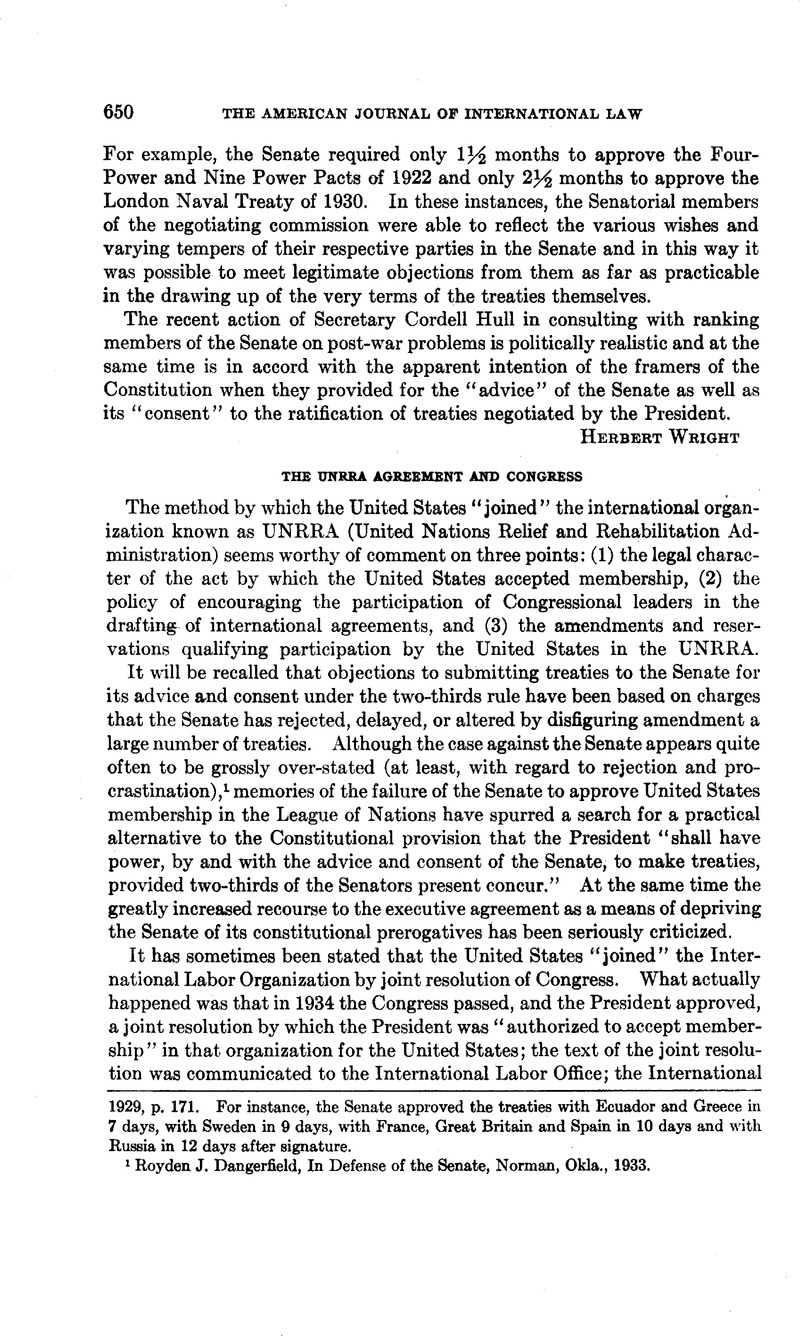Published online by Cambridge University Press: 25 April 2017

1 Royden J. Dangerfield, In Defense of the Senate, Norman, Okla., 1933.
2 Hudson, Manley O., “The Membership of the United States in the International Labor Organization,” this Journal, Vol. 28 (1934), pp. 669–684 Google Scholar. Since the joint resolution was adopted by a unanimous vote in the Senate Judge Hudson regards it as expressing the Senate’s advice and consent in such a way as to meet the requirement of the two-thirds rule. Same, p. 675.
3 Briggs, Herbert W., “Treaties, Executive Agreements, and the Panama Joint Resolution of 1943,” American Political Science Review, Vol. 37 (1943), pp. 686–691 CrossRefGoogle Scholar; Woolsey, Lester H., “Executive Agreements Relating to Panama,” this Journal, Vol. 37 (1943), pp. 482–489 Google Scholar.
4 Hearings before the Committee on Foreign Affairs, House of Representatives, 78th Cong., 1st and 2nd Sess., Dec. 1943-Jan. 1944, on H. J. Res. 192, “To Enable the United States to Participate in the Work of the United Nations Relief and Rehabilitation Administration,” pp. 8, 158, 163 (Cited as House Hearings); House Report No. 994 and Senate Report No. 688 (both 78th Cong., 2nd Sess.). For the text of the Draft Agreement for UNRRA submitted on June 10, 1943, see Department of State Bulletin, Vol. VIII, No. 207 (June 12, 1943), pp. 523–527.
5 Congressional Record, Vol. 90 (78th Cong., 2nd Sess.), p. 1737 (daily edition, Feb. 16, 1944). He added that that conception was “ combatted” by the Senate Foreign Relations Committee.
6 House Hearings, pp. 158–159.
7 First Session of the Council of the United Nations Relief and Rehabilitation Administration: Selected Documents. Department of State, Conference Series 53 (1944), p. 1. For the text of the UNRRA Agreement as signed see pp. 7–20.
8 By Article IX of the Agreement for United Nations Relief and Rehabilitation Administration “this Agreement shall enter into force with respect to each signatory on the date when the Agreement is signed by that signatory, unless otherwise specified by such signatory.” It is perhaps curious—in the light of our Constitutional provision as to the making of treaties—that, although the United States did not sign subject to Senatorial advice and consent, the Agreement was signed on behalf of fourteen Governments (Chile, Colombia, Cuba, Ecuador, Ethiopia, Guatemala, India, Iran, Iraq, Mexico, Nicaragua, Peru, Uruguay, Venezuela) with a reservation or statement to the effect, in each case, that the Agreement was signed subject to ratification or legislative approval. Same, pp. 15–20.
9 See Mr. Sayre’s Statement, quoted above.
10 Congressional Record, Vol. 90, p. 1745 (daily ed., Feb. 16, 1944).
11 Same, p. 1746. Compare Senator Taft’s eomment: “Apparently the Senator suggests that it is a new kind of thing, an executive-congressional agreement, which may be entered into with foreign nations ”. He was quick to add that it “involves the implication that there are certain things which the President cannot do by executive agreement, but which he can do by executive agreement approved by Congress”; same.
12 Same, p. 1745.
13 Same, p. 1749.
14 House Joint Resolution 192, 78th Cong., 2nd Sess. Approved by the President March 28, 1944. Public Law 267.
15 Of the reservation contained in Sec. 7 of the joint resolution, Senator Connally said: “…we tie all this organization’s activities down to relief only. We exclude rehabilitation.” Of Sec. 8, he said: “We are tying the whole Administration, not simply our contribution, but we are tying the whole UNRRA to the proposition. …” 90 Cong. Rec., p. 2850 (daily ed., March 21, 1944). Senator Vandenberg told the Senate that he supported the joint resolution on the theory “that we have tied down Dean Acheson, who speaks for us in the UNRRA, and that we have tied down Director General Lehman.” Same, p. 1740 (Feb. 16, 1944).
16 Same, p. 1746.
17 See above, p. 23.
18 Technically, of course, the Council of the UNRRA only “recommends” the amount of a national contribution: Council of UNRRA, 1st Session, Res. 14 (Financial Plan), Sec. 4; State Department Conference Series 53, p. 45.
19 See the remarks of Senator Connally to the Senate at the time of the Dumbarton Oaks Conference: Congressional Record, Vol. 90, pp. 7255, 7256 (Aug. 22, 1944).